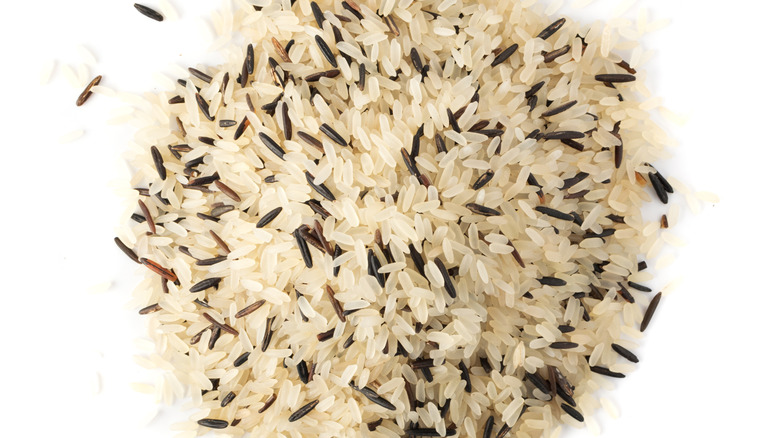Is Wild Rice Good For You?
Is it time to switch up plain old brown rice with wild rice? Both types of rice have similar nutritional value, but some say that wild rice is tastier. With its smoky flavor and rich consistency, it can turn any meal into a feast. You can enjoy it as a side dish, mix it into salads, or add it to soups for a nutritional kick. My Food Data notes that equal servings of wild rice and brown rice have roughly the same calories (100), grams of carbs, and grams of fiber, but wild rice has almost double the amount of protein (4 grams over 2.3 grams). Both rice varieties are rich in iron, magnesium, phosphorus, and manganese.
Surprisingly, wild rice isn't a grain, but the seed of a grass that grows in small lakes (via WebMD). Most varieties come from California and Minnesota, featuring a wide range of colors and shapes. The seed is gluten-free and delivers large doses of healthy fats, niacin, folate, minerals, and antioxidants. These nutrients support cardiovascular health and may protect against diabetes.
Like other types of rice, North American wild rice may contain traces of heavy metals, such as lead and arsenic, reports Science of the Total Environment (per Science Direct). Moreover, according to North Dakota State University, some crops are infected with Claviceps purpurea, a fungus that affects grain quality. Despite these risks, wild rice can be a welcome addition to most diets when consumed in moderation.
Wild rice supports heart health
Several studies conducted over the years suggest that wild rice promotes cardiovascular health and may reduce the risk of heart disease. First of all, its antioxidant activity is 10 to 15 times higher than that of white rice, according to clinical research published in Cereal Chemistry (via the Cereals and Grains Association). Second, wild rice provides large amounts of fiber and plant sterols, along with small amounts of polyunsaturated fats. As the researchers note, these nutrients may help improve blood lipids, including blood cholesterol and triglycerides.
The Agricultural Utilization Research Institute (AURI) explains that sitosterol, campesterol, flavonoids, and other nutrients in wild rice have cardio-protective effects. These bioactive compounds may reduce oxidative stress, insulin resistance, obesity, and other factors linked to heart disease. Clinical evidence from a 2019 study in the journal Nutrients indicates that wild rice may also prevent plaque buildup on the artery walls and decrease inflammation, which may further lower the risk of heart disease. Most studies have mixed results, but the research is promising.
It may also protect against diabetes
Wild rice has a smaller effect on blood sugar levels than other rice varieties, according to AURI. Therefore, it may help improve glycemic control when consumed as part of a healthy diet. This whole grain also provides nearly 3 grams of fiber per cup. Dietary fiber slows sugar absorption into the bloodstream and suppresses appetite, leading to a lower risk of weight gain and diabetes (via Mayo Clinic).
A 2013 study published in the journal Nutrients assessed the effects of wild rice on rats with diabetes. This functional food suppressed insulin resistance and improved glucose metabolism in animals, even when they were on a high-fat, high-cholesterol diet. Based on these findings, researchers recommend swapping white rice and other refined grains for wild rice to prevent metabolic diseases. Note that brown rice has similar benefits. In a 2010 study published in the Archives of Internal Medicine, men and women who consumed at least two servings of brown rice per week had a lower risk of diabetes than those eating less than one serving per month.
AURI also reports that wild rice contains apigenin, suberin, phenolic acids, and other compounds with antioxidant and anti-inflammatory effects. Some of these nutrients may also protect against cancer. On top of that, wild rice is low in calories and fat. As far as toxicity is concerned, boiling can reduce arsenic levels in rice by up to 60%, states the U.S. Food and Drug Administration.



